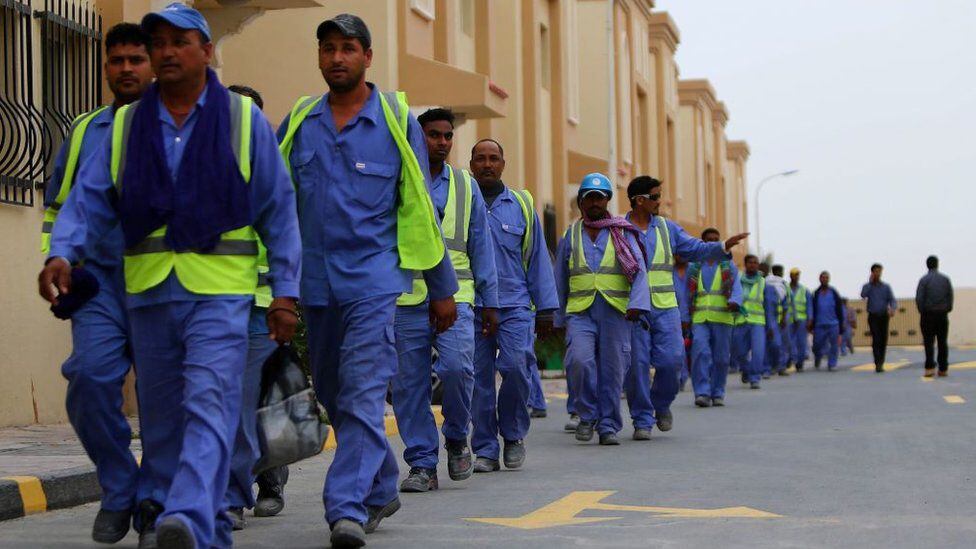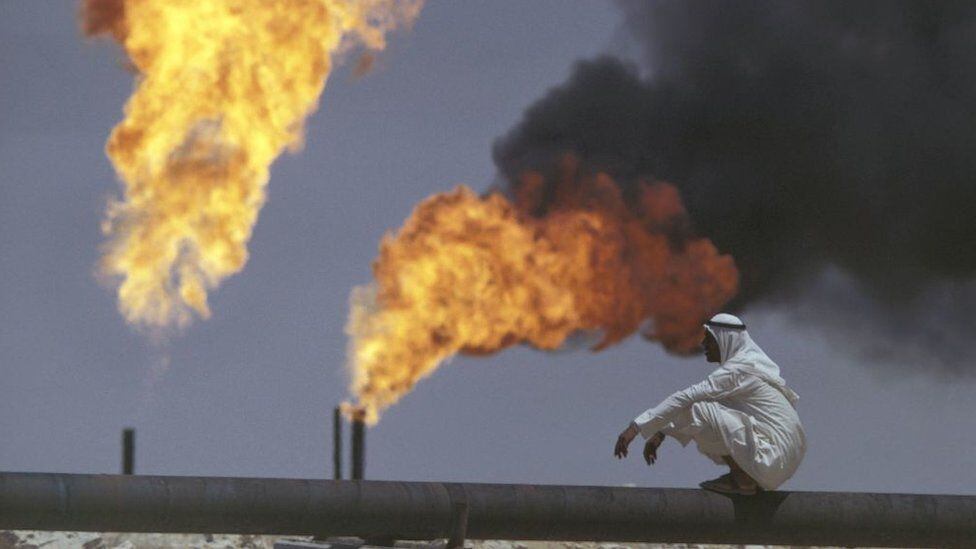Qatar It is one of the most urbanized countries in the world, 99% of its population lives in a city, something that their ancestors would never have imagined, who before the 19th century were mostly Bedouin nomads or fishermen.
According to archaeological evidence, this territory has been populated for almost six centuries and its condition as a peninsula, in the middle of the Red Sea, made it a key naval and commercial post for the region from the beginning.
LOOK: Qatar 2022 runs out of beer in the stadiums: the list of prohibitions, rules and recommendations during the World Cup
The Qatari government highlights on its official sites that the peninsula already appeared in the so-called Map of Arabia by the Greek geographer Ptolemy, who lived in the second century of our era, with the name of Qatra, which would be a reference to the city of Zubara, one of the most important commercial ports in the Gulf. Other historical sources mention that the name Qatar goes back to 50AD when the Roman writer Pliny the Elder referred to the inhabitants of the region as “catharrei”.
The strategic location of this territory in the Persian Gulf led it to play a fundamental role in the preparation of the naval fleets that would transport the Muslim armies during the spread of Islam beginning in the 7th century.
The peninsula prospered first under Arab Abbasid rule from the 8th century and then under the rule of the Ottoman Empire in the 16th century, which ruled the Arabian peninsula for 400 years, until World War I.
In Ottoman times, Portugal would become the first European power to set foot in that region. But then the position of the British Empire would be consolidated.
In 1916, Great Britain signed a treaty with Qatar that established the protection of this territory. According to the official site of the Qatari Foreign Ministry, the British authority “was mainly limited to the supervision of some administrative matters.” But the Royal Encyclopedia Britannica specifies that, among these issues, was precisely the control over Qatar’s foreign policy.
However, this was not the first time that London had negotiated with Qatar. In 1867 a confrontation between the most powerful families in the region opened the doors of the peninsula to the British.
When and how was modern Qatar born?
While the official history of Qatar speaks of the unification of the tribes carried out by Sheikh Mohamed ibn Thani between 1851 and 1878 as the origin of the current Qatar, the Royal British Academy mentions the arrival in 1766 in the Qatari city of Zubara of several families from of Kuwait, particularly the Khalifah family. This last family will leave Qatar in 1783 to conquer the island of Bahrain.
Just as the Al Thani family rules Qatar to this day, the Khalifah family rules Bahrain to this day.
A conflict between the sheikhs of the island and those of the peninsula led to a confrontation in 1867 that left the city of Doha practically destroyed and that first attracted the attention of the British.
“Until the attack, Britain had regarded Qatar as a dependency of Bahrain. It then signed an independence treaty with Mohammed ibn Thani in 1868, which set the course for both Qatar’s future independence and Thani dynasty rule,” says the Encyclopedia Britannica.
The Al Thani family then sailed between two empires, the British and the Ottoman, until World War I, when the second of these powers disappeared. British influence would extend for 100 years, until London announced its decision to withdraw from the Gulf. On September 3, 1971, Qatar declared its independence..

A decade later, the emirate joined its five neighbors – Saudi Arabia, Kuwait, the United Arab Emirates, Bahrain and Oman – to create the Gulf Cooperation Council. Many of them would turn against him in the new century.
When did Qatar become rich and how did this make it a demographically strange country?
Before World War II, the population of Qatar was engaged in trade and, above all, pearl fishing, but this activity began to decline on the peninsula when Japan began to export cultured pearls. But the same year that the world conflict broke out, “black gold” was discovered on the west coast of Dukhan.
The war did not allow oil to be exploited until a decade later. The first concession was granted to the Iraq Petroleum Company (IPC), a group of European and American companies.
Oil revenues sparked internal conflicts within the Al Thani dynasty, which in the second half of the 20th century saw foreign intervention and palace coups. In the 1970s all the oil concessions were nationalized, but private companies continue to play an important role.
Qatari oil reserves are modest compared to those in the region, but its natural gas deposits are among the largest in the world. Natural gas, exploited since the 1990s, surpassed oil as the largest share of government revenue and the country’s GDP in the first decade of the 21st century.
The peninsula’s wealth attracted thousands of foreign workers, especially from Southeast Asian nations such as India, Nepal, Bangladesh, and the Philippines. This caused the country to have some very particular demographic characteristics: of its 2.9 million inhabitants, only 15% are Qataris.
In addition, the number of men exceeds that of women 3 to 1, since only 25% of the population is female.

The mistreatment received by these workers during the construction of the entire World Cup infrastructure (including seven of the eight soccer stadiums, a new airport and a new metro system) has been denounced by the international press and in reports by rights groups. humans, that speak of thousands of deaths from heat and exhaustion.
The official response was reforms to the labor system. “Few countries have come this far in such a short time, and Qatar now leads the region on labor rights,” a government spokesman said.
The International Football Federation (FIFA) has welcomed these changes: “A wide range of measures have been implemented in recent years to improve the protection of workers in Qatar, and these advances have come largely as a result of the celebration of the World Cup in the country”.
But groups like Amnesty International have warned that the task of protecting migrant workers it has been done halfway in the Arab country and that “human rights abuses persist today on a significant scale.

Other criticism facing Qatar ahead of the World Cup is its persecution of homosexuality, which is banned in the country. Organizers have promised a World Cup event where “everyone is welcome”, but LGBTIQ+ organizations have said there are still reasons for concern.
Human Rights Watch recently published a report stating that Qatari security forces continue to detain gay, lesbian and transgender citizens, sometimes forcing them to to undergo conversion therapy.
Islam is the official religion in Qatar. The majority are Sunni Muslims although there is a small Shiite minority. The ruling dynasty adheres to Whahabism, the same interpretation of Islam as Saudi Arabia. Foreign migrants are divided between Muslims, Christians and Hindus.
Why was Qatar isolated by 5 of its neighbors and had to import cows?
In addition to being the first Arab country to host a World Cup, Qatar is the smallest country of all those that have hosted the tournament. It is about 160 km from north to south and about 80 km from east to west.
Fatma Al-Nuaimi, executive director of communications for the tournament’s organizing committee, has called it a “compact” World Cup, with the added attraction of attending more than one match a day, because the greatest distance between two stadiums will be 55 km and some of them are less than 10 km from each other.

Al-Nuaimi added that the tournament “will showcase the best of Arab and Qatari hospitality and will open its doors to the entire region.”
This “openness” was hard to imagine a few years ago, when the entire region had isolated Qatar. But it is necessary to go back more than three decades to understand what happened between 2013 and 2021. Between 1990 and 1991 Qatar took a big step on the international stage when its troops participated in the First Gulf War on the side of the international coalition led by Washington to Defend Kuwait from the Iraqi invasion.
After this participation, Qatar allowed US military forces to use its territory to deploy equipment and use the airstrips, which would be essential in the campaign against Afghanistan in 2001. Two years later, this Arab nation became the headquarters of the operations of the USA in the Second Gulf War against Iraq.
In the 1990s, the new income from gas exploitation led the country to invest in its internal development and its international image, with cultural and media projects. such as the promotion of the international television channel al-Jazeerawhich often sparked conflicts with other Arab countries and Qatar due to its journalistic coverage.
In June 2014, three journalists from this network were sentenced to seven years in prison in Egypt on terrorism-related charges, following the fall of the Muslim Brotherhood from power a year earlier.
Qatar’s support for this Islamic group caused Saudi Arabia, Bahrain and the United Arab Emirates (members of the Gulf Cooperation Council) to temporarily withdraw their ambassadors from Doha that year.

In June 2017, Egypt and these three nations cut diplomatic ties and promoted an economic blockade against Qatar, accusing it of supporting Islamist groups and of having close relations with Iran, Saudi Arabia’s main regional rival.
The wealth of the country and its favorable environment for international business allowed him to absorb the shock of isolation from his neighbors. For this, it sought new markets such as Turkey, Kuwait and Southeast Asia, left OPEC (Organization of the Petroleum Exporting Countries) and did not hesitate to use all its resources to offset its losses.
The Royal Encyclopedia Britannica highlights, for example, that at the beginning of the bloc all milk products that were purchased in neighboring markets disappeared. So Qatar moved thousands of cows to the peninsula and in a short time became self-sufficient in dairy products.
In January 2021 the blockade was officially lifted.
Source: Elcomercio
I am Jack Morton and I work in 24 News Recorder. I mostly cover world news and I have also authored 24 news recorder. I find this work highly interesting and it allows me to keep up with current events happening around the world.

:quality(75)/cloudfront-us-east-1.images.arcpublishing.com/elcomercio/GE3TANRNGEYS2MRQKQYDAORRG4.jpg)

:quality(75)/cloudfront-us-east-1.images.arcpublishing.com/elcomercio/C6BR54ROLZGDXE4BBBG6A6D2CI.jpg)
:quality(75)/cloudfront-us-east-1.images.arcpublishing.com/elcomercio/6T5VR63ZIVHVHIZXGIZCSUVBCM.jpg)


